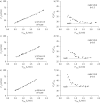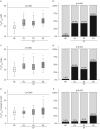Ventilatory efficiency and its clinical and prognostic value in adults with cystic fibrosis
- PMID: 34853094
- PMCID: PMC9488122
- DOI: 10.1183/16000617.0395-2020
Ventilatory efficiency and its clinical and prognostic value in adults with cystic fibrosis
Abstract
Cystic fibrosis, due to the absence or abnormal function of the cystic fibrosis transmembrane conductance regulator, is the most common life-limiting autosomal recessive genetic disorder among the Caucasian population. The lungs are particularly affected due to thick and tenacious mucus causing parenchymal anomalies ranging from bronchiectasis, progressive airflow limitation, respiratory infections, lung destruction and ultimately respiratory failure. Despite the remarkable advances in treatment that have greatly improved survival, most patients experience progressive exercise curtailment, with the consequence that a growing number of patients with cystic fibrosis will be referred for exercise-based evaluations in the forthcoming years. Cardiopulmonary exercise testing, in particular, is a useful tool to assess the mechanisms of exercise intolerance in individual patients that may have treatment and prognostic implications. In this review, we will focus on ventilatory efficiency and its clinical and prognostic value in adults with cystic fibrosis.
Copyright ©The authors 2021.
Conflict of interest statement
Conflict of interest: P. Laveneziana reports personal fees from Novartis France, Chiesi France and Boehringer France, outside the submitted work. Conflict of interest: P. Palange has nothing to disclose.
Figures


Comment in
- doi: 10.1183/16000617.0244-2020
- doi: 10.1183/16000617.0141-2020
- doi: 10.1183/16000617.0160-2020
- doi: 10.1183/16000617.0187-2020
- doi: 10.1183/16000617.0182-2020
- doi: 10.1183/16000617.0206-2020
- doi: 10.1183/16000617.0225-2020
- doi: 10.1183/16000617.0214-2020
- doi: 10.1183/16000617.0190-2020
- doi: 10.1183/16000617.0178-2020
References
Publication types
MeSH terms
LinkOut - more resources
Full Text Sources
Medical
